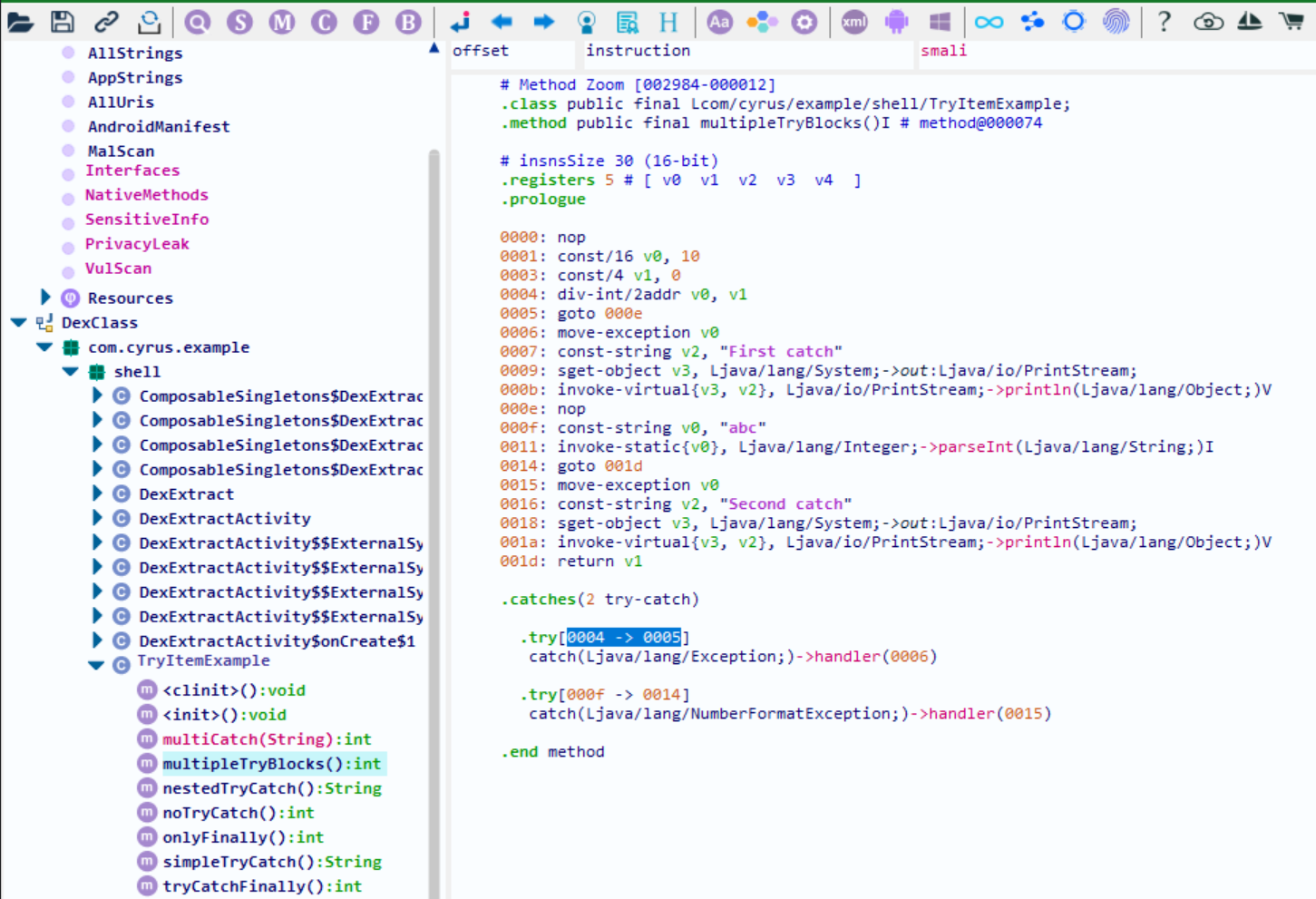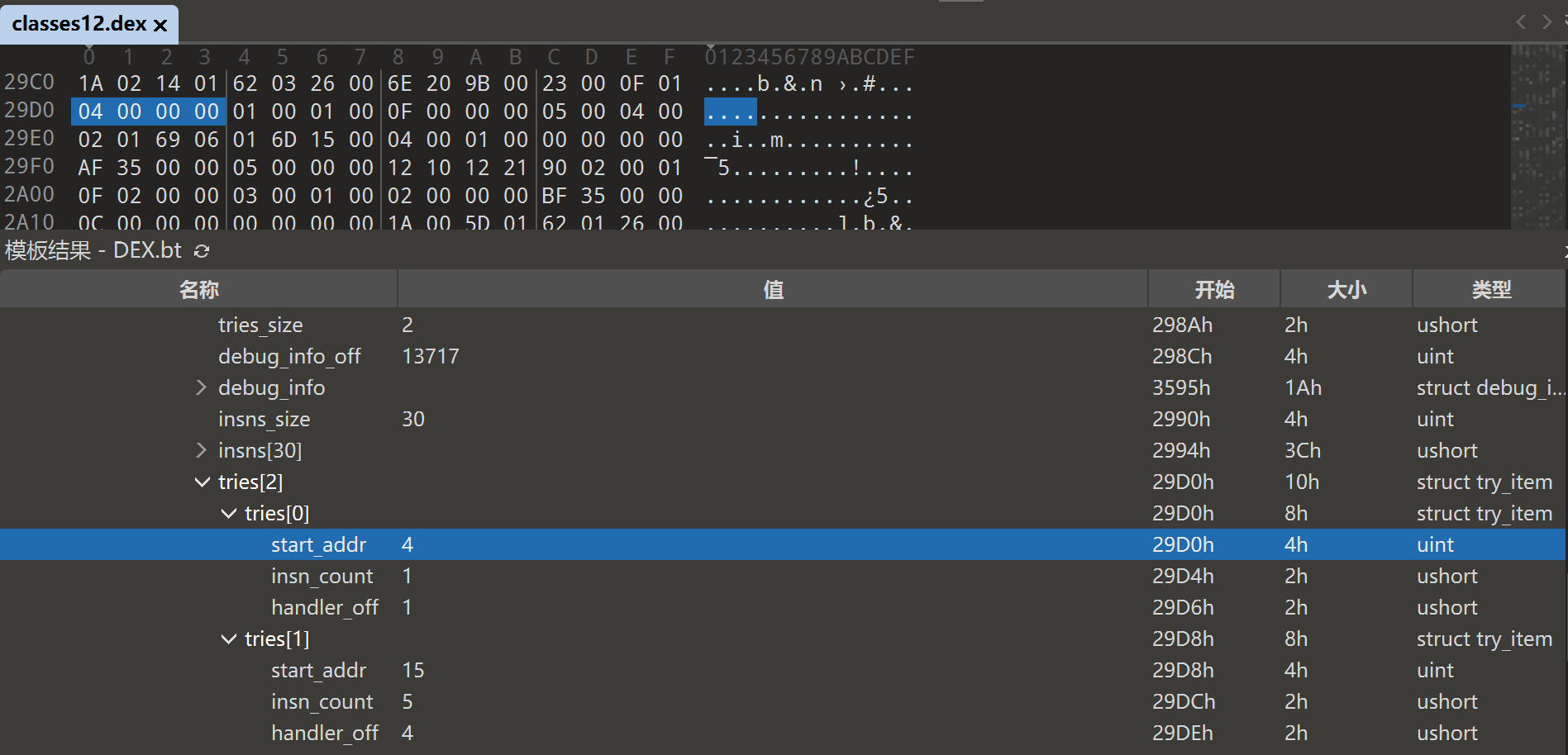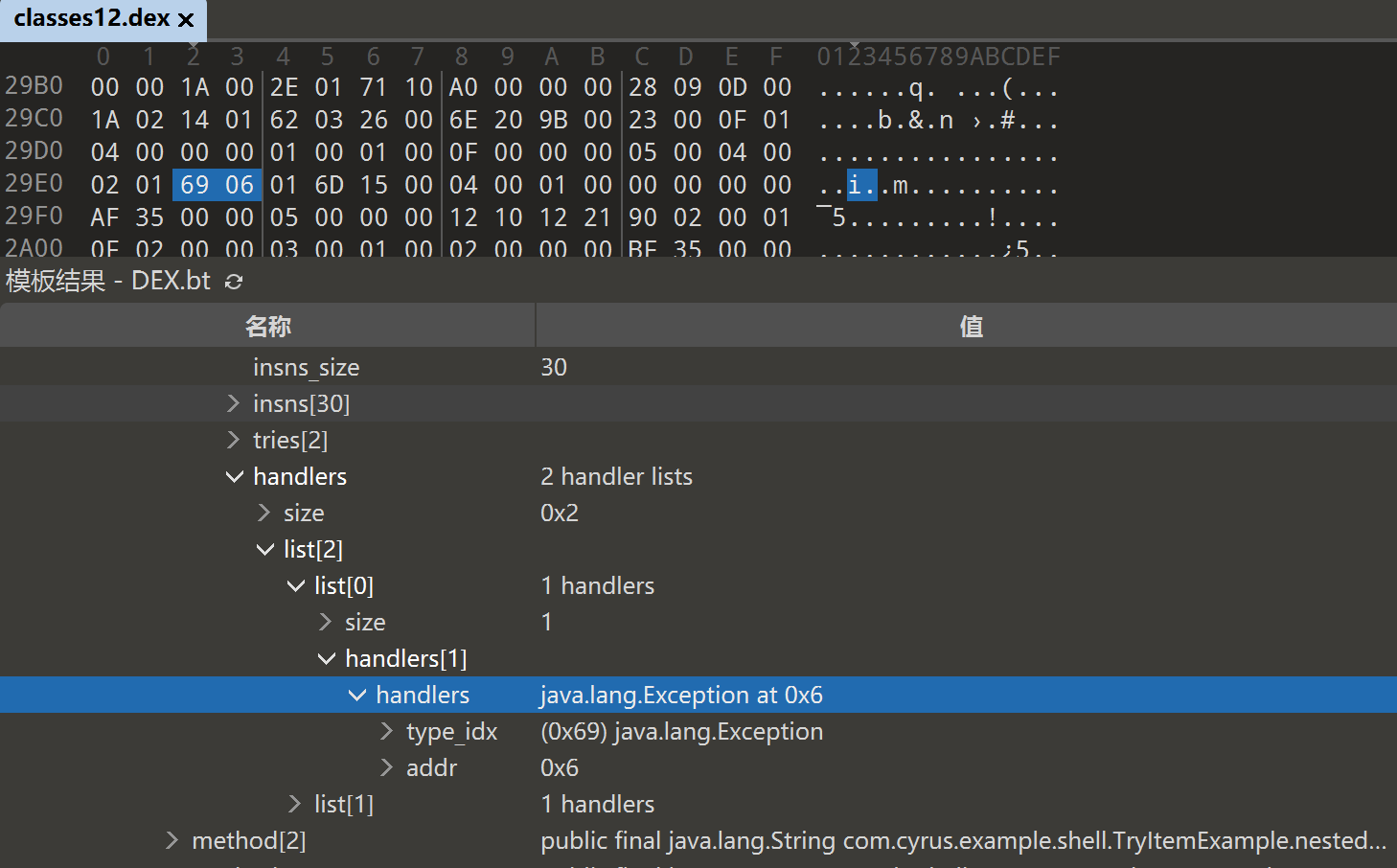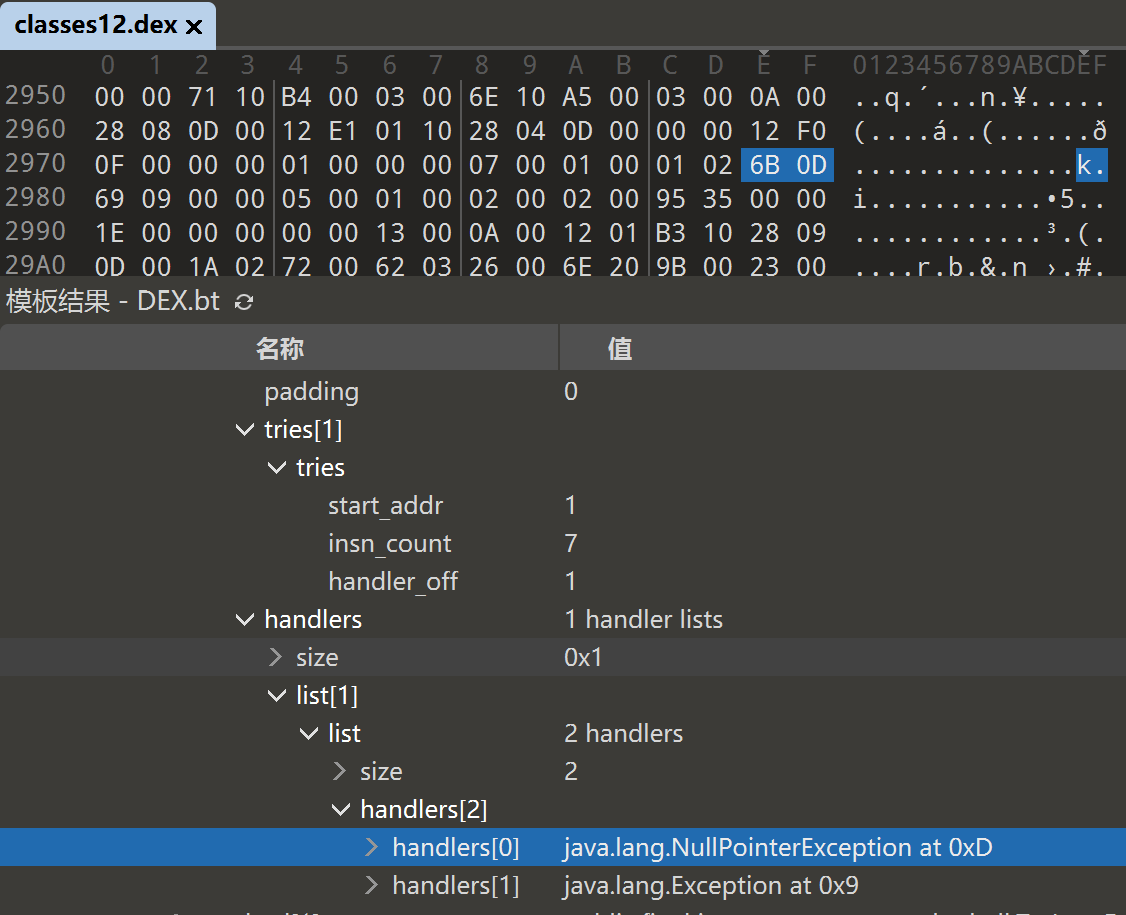版权归作者所有,如有转发,请注明文章出处:https://cyrus-studio.github.io/blog/
现有脱壳方法存在的问题
脱壳粒度集中在 DexFile 整体,当前对 apk 保护的粒度在函数粒度,这就导致了脱壳与加固的不对等,无法应对函数粒度的加固保护。
Dalvik 下的基于主动调用的自动化脱壳方案,首次将粒度下降到函数粒度
存在问题:
1、Dalvik 慢慢淡出视野,无法应对 ART 环境
2、当前没有一个好的脱壳修复框架,无法应用到 VMP 函数的修复
主动调用相关概念
1、被动调用
指 app 正常运行过程中发生的调用,该过程只对 dex 中部分的类完成了加载,同时也只是对 dex 中的部分函数完成了调用。
2、主动调用
通过构造虚拟调用,从而达到欺骗 "壳" ,让壳误以为 app 在执行正常的函数调用流程从而达成对 dex 中所有类函数的虚拟调用。
被动调用也可以用来完成函数粒度的修复。如当前通过正常运行 app ,待 app 将 dex 中的类正常加载并完成相关的函数的正常调用后再进行 dex 的 dump 的脱壳方法。
被动调用脱壳的缺点: 存在修复函数不全的问题。由于测试用例无法覆盖 dex 中所有的函数,导致代码覆盖率低,只能对 app 运行过程中调用过的函数的修复。
主动调用的优点: 能够覆盖 dex 中所有的函数,从而完成更彻底的函数粒度的修复。同时,函数的修复准确度同主动调用链的构造深度有关。
FART 中要解决的三个问题
1、如何构造主动调用链并让每一个函数都到达主动调用过程,但是又不影响 app 的正常运行?
2、如何根据 ArtMethod 定位内存中对应的 CodeItem 的起始地址?
3、如何遍历 dex 中的所有函数并完成主动调用?
如何构造主动调用链?
标准 Java 函数调用示例代码:
// 1. 查找 Java 类
jclass clazz = env->FindClass("com/cyrus/example/jniexample/JNIExample");
if (clazz == nullptr) {
LOGI("Class not found");
return env->NewStringUTF("Class not found");
}
// 2. 获取 Java 方法 ID
jmethodID methodId = env->GetStaticMethodID(clazz, "helloFromJava", "()Ljava/lang/String;");
if (methodId == nullptr) {
LOGI("Method not found");
return env->NewStringUTF("Method not found");
}
// 3. 调用 Java 方法
jstring resultStr = (jstring) env->CallStaticObjectMethod(clazz, methodId);标准流程:
-
通过 FindClass 得到 jclass
-
通过 GetStaticMethodID / GetMethodId 得到 jmethodID
-
通过一系列 Call 开头的函数完成调用(比如这里的 CallStaticObjectMethod)
FindClass
FindClass 的作用: 通过 ClassLinker 的 FindClass 取得目标类的 jclass
static jclass FindClass(JNIEnv* env, const char* name) {
CHECK_NON_NULL_ARGUMENT(name);
Runtime* runtime = Runtime::Current();
ClassLinker* class_linker = runtime->GetClassLinker();
std::string descriptor(NormalizeJniClassDescriptor(name));
ScopedObjectAccess soa(env);
ObjPtr<mirror::Class> c = nullptr;
if (runtime->IsStarted()) {
StackHandleScope<1> hs(soa.Self());
Handle<mirror::ClassLoader> class_loader(hs.NewHandle(GetClassLoader(soa)));
c = class_linker->FindClass(soa.Self(), descriptor.c_str(), class_loader);
} else {
c = class_linker->FindSystemClass(soa.Self(), descriptor.c_str());
}
return soa.AddLocalReference<jclass>(c);
}GetMethodID / GetStaticMethodID 的作用:根据 jclass 对象、方法名和签名信息取得对应的 ArtMethod 用于下一步的调用
static jmethodID GetMethodID(JNIEnv* env, jclass java_class, const char* name, const char* sig) {
CHECK_NON_NULL_ARGUMENT(java_class);
CHECK_NON_NULL_ARGUMENT(name);
CHECK_NON_NULL_ARGUMENT(sig);
ScopedObjectAccess soa(env);
return FindMethodID(soa, java_class, name, sig, false);
}
static jmethodID GetStaticMethodID(JNIEnv* env, jclass java_class, const char* name,
const char* sig) {
CHECK_NON_NULL_ARGUMENT(java_class);
CHECK_NON_NULL_ARGUMENT(name);
CHECK_NON_NULL_ARGUMENT(sig);
ScopedObjectAccess soa(env);
return FindMethodID(soa, java_class, name, sig, true);
}FindMethodID
GetStaticMethodID 和 GetMethodID 最终都是走到 FindMethodID ,只是传参 is_static 不同
static jmethodID FindMethodID(ScopedObjectAccess& soa, jclass jni_class,
const char* name, const char* sig, bool is_static)
REQUIRES_SHARED(Locks::mutator_lock_) {
ObjPtr<mirror::Class> c = EnsureInitialized(soa.Self(), soa.Decode<mirror::Class>(jni_class));
if (c == nullptr) {
return nullptr;
}
ArtMethod* method = nullptr;
auto pointer_size = Runtime::Current()->GetClassLinker()->GetImagePointerSize();
if (c->IsInterface()) {
method = c->FindInterfaceMethod(name, sig, pointer_size);
} else {
method = c->FindClassMethod(name, sig, pointer_size);
}
if (method != nullptr && ShouldDenyAccessToMember(method, soa.Self())) {
method = nullptr;
}
if (method == nullptr || method->IsStatic() != is_static) {
ThrowNoSuchMethodError(soa, c, name, sig, is_static ? "static" : "non-static");
return nullptr;
}
return jni::EncodeArtMethod(method);
}最后返回的是 jni::EncodeArtMethod(method),这是 ART 中将 ArtMethod* 转换为 jmethodID 的封装过程。
ALWAYS_INLINE
static inline jmethodID EncodeArtMethod(ArtMethod* art_method) {
return reinterpret_cast<jmethodID>(art_method);
}jmethodID 在 ART 中其实就是一个 ArtMethod*,而 EncodeArtMethod 就是把 ArtMethod* 安全地封装成 jmethodID。
CallObjectMethod
CallObjectMethod / CallStaticObjectMethod 函数源码如下:
static jobject CallObjectMethod(JNIEnv* env, jobject obj, jmethodID mid, ...) {
va_list ap;
va_start(ap, mid);
ScopedVAArgs free_args_later(&ap);
CHECK_NON_NULL_ARGUMENT(obj);
CHECK_NON_NULL_ARGUMENT(mid);
ScopedObjectAccess soa(env);
JValue result(InvokeVirtualOrInterfaceWithVarArgs(soa, obj, mid, ap));
return soa.AddLocalReference<jobject>(result.GetL());
}
static jobject CallStaticObjectMethod(JNIEnv* env, jclass, jmethodID mid, ...) {
va_list ap;
va_start(ap, mid);
ScopedVAArgs free_args_later(&ap);
CHECK_NON_NULL_ARGUMENT(mid);
ScopedObjectAccess soa(env);
JValue result(InvokeWithVarArgs(soa, nullptr, mid, ap));
jobject local_result = soa.AddLocalReference<jobject>(result.GetL());
return local_result;
}InvokeVirtualOrInterfaceWithVarArgs 与 InvokeWithVarArgs
JValue InvokeVirtualOrInterfaceWithVarArgs(const ScopedObjectAccessAlreadyRunnable& soa,
jobject obj, jmethodID mid, va_list args) {
// We want to make sure that the stack is not within a small distance from the
// protected region in case we are calling into a leaf function whose stack
// check has been elided.
if (UNLIKELY(__builtin_frame_address(0) < soa.Self()->GetStackEnd())) {
ThrowStackOverflowError(soa.Self());
return JValue();
}
ObjPtr<mirror::Object> receiver = soa.Decode<mirror::Object>(obj);
ArtMethod* method = FindVirtualMethod(receiver, jni::DecodeArtMethod(mid));
bool is_string_init = method->GetDeclaringClass()->IsStringClass() && method->IsConstructor();
if (is_string_init) {
// Replace calls to String.<init> with equivalent StringFactory call.
method = WellKnownClasses::StringInitToStringFactory(method);
receiver = nullptr;
}
uint32_t shorty_len = 0;
const char* shorty =
method->GetInterfaceMethodIfProxy(kRuntimePointerSize)->GetShorty(&shorty_len);
JValue result;
ArgArray arg_array(shorty, shorty_len);
arg_array.BuildArgArrayFromVarArgs(soa, receiver, args);
InvokeWithArgArray(soa, method, &arg_array, &result, shorty);
if (is_string_init) {
// For string init, remap original receiver to StringFactory result.
UpdateReference(soa.Self(), obj, result.GetL());
}
return result;
}
JValue InvokeWithVarArgs(const ScopedObjectAccessAlreadyRunnable& soa, jobject obj, jmethodID mid,
va_list args)
REQUIRES_SHARED(Locks::mutator_lock_) {
// We want to make sure that the stack is not within a small distance from the
// protected region in case we are calling into a leaf function whose stack
// check has been elided.
if (UNLIKELY(__builtin_frame_address(0) < soa.Self()->GetStackEnd())) {
ThrowStackOverflowError(soa.Self());
return JValue();
}
ArtMethod* method = jni::DecodeArtMethod(mid);
bool is_string_init = method->GetDeclaringClass()->IsStringClass() && method->IsConstructor();
if (is_string_init) {
// Replace calls to String.<init> with equivalent StringFactory call.
method = WellKnownClasses::StringInitToStringFactory(method);
}
ObjPtr<mirror::Object> receiver = method->IsStatic() ? nullptr : soa.Decode<mirror::Object>(obj);
uint32_t shorty_len = 0;
const char* shorty =
method->GetInterfaceMethodIfProxy(kRuntimePointerSize)->GetShorty(&shorty_len);
JValue result;
ArgArray arg_array(shorty, shorty_len);
arg_array.BuildArgArrayFromVarArgs(soa, receiver, args);
InvokeWithArgArray(soa, method, &arg_array, &result, shorty);
if (is_string_init) {
// For string init, remap original receiver to StringFactory result.
UpdateReference(soa.Self(), obj, result.GetL());
}
return result;
}所以,无论是静态方法还是非静态方法最终都会调用到 InvokeWithArgArray
void InvokeWithArgArray(const ScopedObjectAccessAlreadyRunnable& soa,
ArtMethod* method, ArgArray* arg_array, JValue* result,
const char* shorty)
REQUIRES_SHARED(Locks::mutator_lock_) {
uint32_t* args = arg_array->GetArray();
if (UNLIKELY(soa.Env()->IsCheckJniEnabled())) {
CheckMethodArguments(soa.Vm(), method->GetInterfaceMethodIfProxy(kRuntimePointerSize), args);
}
method->Invoke(soa.Self(), args, arg_array->GetNumBytes(), result, shorty);
}结论:对于 Java 函数的调用,最终由该函数对应的 ArtMethod 对象的 Invoke 函数完成。
如何 dump CodeItem?
dumpMethodCode
DexFIle 类添加 native 函数 dumpMethodCode,用于提取指定 ArtMethod 对应的 Dex 字节码(CodeItem)。
static void DexFile_dumpMethodCode(JNIEnv* env, jclass, jobject method) {
// 将当前线程从 kNative 状态切换到 kRunnable,表示线程可以安全访问 Java 对象(如 jobject)。
ScopedFastNativeObjectAccess soa(env);
// 如果 Java 传入的 Method 不为 null
if(method != nullptr){
// 将 java.lang.reflect.Method 转换为 ART 内部的 ArtMethod 指针
ArtMethod* artmethod = ArtMethod::FromReflectedMethod(soa, method);
// 调用 myfartInvoke
myfartInvoke(artmethod);
}
return;
}libcore/dalvik/src/main/java/dalvik/system/DexFile.java
public final class DexFile {
private static native void dumpMethodCode(Object m);
}myfartInvoke 方法中主动调用 ArtMethod 的 Invoke 方法
extern "C" void myfartInvoke(ArtMethod * artmethod) SHARED_LOCKS_REQUIRED(Locks::mutator_lock_) {
JValue *result = nullptr;
Thread *self = nullptr;
uint32_t temp = 6;
uint32_t *args = &temp;
uint32_t args_size = 6;
artmethod->Invoke(self, args, args_size, result, "fart");
}在 ArtMethod::Invoke 方法中,检测到 self 是 nullptr,也就是 myfartInvoke 的主动调用时,调用 dumpArtMethod 把解密后的函数 dump 下来
void ArtMethod::Invoke(Thread * self, uint32_t * args, uint32_t args_size, JValue * result,
const char *shorty) {
if (self == nullptr) {
dumpArtMethod(this);
return;
}
...
}art/runtime/art_method.cc
获取 CodeItem 起始地址
CodeItem 起始地址就在 ArtMethod 的 dex_code_item_offset_ 字段。
不同 Android 版本略有不同
通过 GetCodeItemOffset() 方法拿到 CodeItem 的起始地址
CodeItem 结构定义
Android 源码中 CodeItem 的结构定义如下:
struct CodeItem : public dex::CodeItem {
// DEX 字节码必须按照 4 字节对齐
static constexpr size_t kAlignment = 4;
private:
// 方法使用的虚拟寄存器数量(包括本地变量和参数)
uint16_t registers_size_;
// 方法的入参占用的寄存器数量
uint16_t ins_size_;
// 方法调用其他方法时所需的最大出参寄存器数量(即调用其他方法时的参数空间)
uint16_t outs_size_;
// try-catch 块的数量。如果不为 0,则在 insns_ 后紧跟 try_item 和 catch_handler。
uint16_t tries_size_;
// 调试信息在 DEX 文件中的偏移,指向 debug_info 结构
// 包括局部变量名、源码行号映射等
uint32_t debug_info_off_;
// 指令(insns_)数组长度,单位是 2 字节(code units)
// 每条指令通常是 2 字节对齐,有些指令占用多个 code unit
uint32_t insns_size_in_code_units_;
// 指令数组(实际大小是可变的,柔性数组)
// 存放 DEX 字节码指令,insns_size_in_code_units_ 表示其长度
uint16_t insns_[1];
};CodeItem 前 16 字节是固定结构
| 字节偏移 | 字段名 | 含义说明 | 大小(字节) |
|---|---|---|---|
| 0x00 | registers_size_ | 方法使用的寄存器数(本地变量 + 参数) | 2 |
| 0x02 | ins_size_ | 方法参数占用的寄存器数(入参) | 2 |
| 0x04 | outs_size_ | 调用其他方法所需的最大出参寄存器数(临时参数空间) | 2 |
| 0x06 | tries_size_ | try-catch 块数量,非 0 时表示有异常处理结构 | 2 |
| 0x08 | debug_info_off_ | 调试信息在 DEX 文件中的偏移 | 4 |
| 0x0C | insns_size_in_code_units_ | 指令数组长度(单位为 2 字节 code unit) | 4 |
| 共计 | 16 字节 |
CodeItem 前 16 字节是方法的执行元信息,后面的 insns_ 是变长的字节码数组,长度由 insns_size_in_code_units_ 决定,之后可能还有异常处理相关结构(try_items 和 catch_handlers)。
TryItem
TryItem 结构体源码如下 :
// Raw try_item.
struct TryItem {
uint32_t start_addr_;
uint16_t insn_count_;
uint16_t handler_off_;
};| 字段名 | 类型 | 说明 |
|---|---|---|
| start_addr_ | uint32_t | 指向 code_item->insns[] 的某个偏移,表示 try 块的起始位置(单位为 16-bit 指令) |
| insn_count_ | uint16_t | try 块中包含多少条指令(单位为 16-bit 指令) |
| handler_off_ | uint16_t | 是 hander 结构的偏移,这个偏移是从 insns_ + sizeof(TryItem) * tries_size_ 开始的,用于描述 catch/finally 的处理逻辑 |
完整示例:带各种 TryItem 情况的 Kotlin 类
package com.cyrus.example.shell
class TryItemExample {
// ✅ 0. 没有 try-catch(不会生成 TryItem)
fun noTryCatch(): Int {
val a = 1
val b = 2
return a + b
}
// ✅ 1. 简单 try-catch(一个 TryItem)
fun simpleTryCatch(): String {
return try {
val x = 10 / 2
"Result: $x"
} catch (e: Exception) {
"Caught Exception"
}
}
// ✅ 2. 多个 catch 分支(一个 TryItem,多个 handler entry)
fun multiCatch(input: String?): Int {
return try {
input!!.length
} catch (e: NullPointerException) {
-1
} catch (e: Exception) {
-2
}
}
// ✅ 3. try-catch-finally(一个 TryItem + finally handler)
fun tryCatchFinally(): Int {
return try {
1 / 0
} catch (e: ArithmeticException) {
-100
} finally {
println("finally block executed")
}
}
// ✅ 4. 嵌套 try-catch(两个 TryItem,嵌套结构)
fun nestedTryCatch(): String {
return try {
try {
val data = "123".toInt()
"Parsed: $data"
} catch (e: NumberFormatException) {
"Inner Catch"
}
} catch (e: Exception) {
"Outer Catch"
}
}
// ✅ 5. 只有 finally,无 catch(一个 TryItem,无 handler entry)
fun onlyFinally(): Int {
try {
val x = 1 + 1
} finally {
println("executing finally without catch")
}
return 0
}
// ✅ 6. 多个独立 try 块(多个 TryItem,非嵌套)
fun multipleTryBlocks(): Int {
try {
val a = 10 / 2
} catch (e: Exception) {
println("First catch")
}
try {
val b = "abc".toInt()
} catch (e: NumberFormatException) {
println("Second catch")
}
return 0
}
}编译运行得到 dex 文件

通过 GDA 查看 dex 中 multipleTryBlocks 函数的 TryItem 信息,可以看到 0004 到 0005 就是第一个 try 块的开始和结束地址

在 010Editor 中打开 dex ,在如下路径
dex_class_defs/class_def[17]/class_def[11] public final com.cyrus.example.shell.TryItemExample/class_data/virtual_methods/method[1] public final int com.cyrus.example.shell.TryItemExample.multipleTryBlocks()/code/tries[2]可以看到 TryItem 数据

CatchHandlerItem
在 DEX 文件中,TryItem 表示一个异常捕获区域,其对应的异常处理器(handler)由 remaining_count_ 指示 catch/finally 块的数量和类型:
-
如果 remaining_count_ <= 0 表示最后一个是 finally 块。
-
如果 remaining_count_ > 0 表示只有 catch 块。
-
remaining_count_ 的绝对值表示 catch 块的个数。
-
如果 remaining_count_ == 0 表示没有 catch 块,只有 finally 块。
CatchHandlerItem:表示一个 catch 分支(即一个异常类型和对应的处理地址)。
class CatchHandlerIterator {
...
struct CatchHandlerItem {
dex::TypeIndex type_idx_; // 捕获异常的类型索引(指向 Dex 文件中的 type_ids 表)
uint32_t address_; // 异常处理器的代码地址(从 code_item.insns 的偏移量)
} handler_;
const uint8_t* current_data_; // the current handler in dex file.
int32_t remaining_count_; // number of handlers not read.
bool catch_all_; // is there a handler that will catch all exceptions in case
// that all typed handler does not match.
};在 010Editor 中打开 dex ,在如下路径
dex_class_defs/class_def[17]/class_def[11] public final com.cyrus.example.shell.TryItemExample/class_data/virtual_methods/method[1] public final int com.cyrus.example.shell.TryItemExample.multipleTryBlocks()/code/handlers可以看到 CatchHandlerItem 数据

一个 TryItem 对应一个 CatchHandlerIterator ,CatchHandlerIterator 中有一个或多个 CatchHandlerItem,共同组成 try catch/finally 块。

CodeItem 的长度计算和 dump
CodeItem 的长度计算和 dump,两种情况:
-
无异常处理
-
有异常处理
具体实现代码在 FART 项目 art/runtime/art_method.cc 的 dumpArtMethod 函数里
extern "C" void dumpArtMethod(ArtMethod * artmethod) SHARED_LOCKS_REQUIRED(Locks::mutator_lock_) {
// 分配临时路径缓冲区
char *dexfilepath = (char *) malloc(sizeof(char) * 2000);
if (dexfilepath == nullptr) {
LOG(INFO) << "ArtMethod::dumpArtMethod invoked, methodname: "
<< PrettyMethod(artmethod).c_str()
<< " malloc 2000 byte failed";
return;
}
// 获取进程名(用于保存路径)
int fcmdline = -1;
char szCmdline[64] = { 0 };
char szProcName[256] = { 0 };
int procid = getpid();
sprintf(szCmdline, "/proc/%d/cmdline", procid);
fcmdline = open(szCmdline, O_RDONLY, 0644);
if (fcmdline > 0) {
read(fcmdline, szProcName, 256);
close(fcmdline);
}
// 如果成功获取进程名
if (szProcName[0]) {
// 获取方法所属的 DexFile
const DexFile *dex_file = artmethod->GetDexFile();
const char *methodname = PrettyMethod(artmethod).c_str();
const uint8_t *begin_ = dex_file->Begin(); // dex 数据起始地址
size_t size_ = dex_file->Size(); // dex 大小
// 创建 fart 路径
memset(dexfilepath, 0, 2000);
sprintf(dexfilepath, "%s", "/sdcard/fart");
mkdir(dexfilepath, 0777);
// 创建 fart/进程名 路径
memset(dexfilepath, 0, 2000);
sprintf(dexfilepath, "/sdcard/fart/%s", szProcName);
mkdir(dexfilepath, 0777);
// 保存 dex 文件到 /sdcard/fart/进程名/xxx_dexfile.dex
memset(dexfilepath, 0, 2000);
sprintf(dexfilepath, "/sdcard/fart/%s/%d_dexfile.dex", szProcName, (int)size_);
int dexfilefp = open(dexfilepath, O_RDONLY, 0666);
if (dexfilefp > 0) {
// 如果文件已存在,不再写入
close(dexfilefp);
dexfilefp = 0;
} else {
// 写入完整 dex 数据
dexfilefp = open(dexfilepath, O_CREAT | O_RDWR, 0666);
if (dexfilefp > 0) {
write(dexfilefp, (void *) begin_, size_);
fsync(dexfilefp);
close(dexfilefp);
}
}
// 获取该方法的 CodeItem(即字节码结构体)
const DexFile::CodeItem * code_item = artmethod->GetCodeItem();
if (LIKELY(code_item != nullptr)) {
int code_item_len = 0;
uint8_t *item = (uint8_t *) code_item;
// 如果有异常处理结构,计算尾部偏移
if (code_item->tries_size_ > 0) {
const uint8_t *handler_data = (const uint8_t *) (DexFile::GetTryItems(*code_item, code_item->tries_size_));
// 解析 handler 数据结构,返回 handler 数据结束的指针位置
uint8_t *tail = codeitem_end(&handler_data);
code_item_len = (int) (tail - item);
} else {
// 没有 try 块,长度 = 16字节头部 + 指令长度(每个指令2字节)
code_item_len = 16 + code_item->insns_size_in_code_units_ * 2;
}
// 组合保存路径
memset(dexfilepath, 0, 2000);
int size_int = (int) dex_file->Size();
uint32_t method_idx = artmethod->get_method_idx();
sprintf(dexfilepath, "/sdcard/fart/%s/%d_%ld.bin", szProcName, size_int, gettidv1());
// 打开保存 CodeItem 信息的文件
int fp2 = open(dexfilepath, O_CREAT | O_APPEND | O_RDWR, 0666);
if (fp2 > 0) {
lseek(fp2, 0, SEEK_END);
// 写入方法信息(name、method_idx、offset、code_item_len)
memset(dexfilepath, 0, 2000);
int offset = (int)(item - begin_);
sprintf(dexfilepath,
"{name:%s,method_idx:%d,offset:%d,code_item_len:%d,ins:",
methodname, method_idx, offset, code_item_len);
int contentlength = strlen(dexfilepath);
write(fp2, (void *) dexfilepath, contentlength);
// base64 编码指令数据并写入
long outlen = 0;
char *base64result = base64_encode((char *) item, (long)code_item_len, &outlen);
write(fp2, base64result, outlen);
write(fp2, "};", 2);
fsync(fp2);
close(fp2);
// 清理内存
if (base64result != nullptr) {
free(base64result);
base64result = nullptr;
}
}
}
}
// 释放路径缓冲区
if (dexfilepath != nullptr) {
free(dexfilepath);
dexfilepath = nullptr;
}
}解析 CodeItem 的异常处理数据部分,返回 handler 数据结束的指针位置
uint8_t *codeitem_end(const uint8_t **pData) {
// 读取 handler 列表的数量(即有多少个 try 块)
uint32_t num_of_list = DecodeUnsignedLeb128(pData);
// 遍历每个 try 块的 handler 列表
for (; num_of_list > 0; num_of_list--) {
// 读取当前 handler 列表中 handler 的数量,可能为负值,表示存在 catch-all handler
int32_t num_of_handlers = DecodeSignedLeb128(pData);
// 取绝对值,得到实际的 type-handler 对数量
int num = num_of_handlers;
if (num_of_handlers <= 0) {
num = -num_of_handlers; // catch-all handler 也算在内,但单独处理
}
// 读取每个 handler 的 type_idx 和 address
for (; num > 0; num--) {
DecodeUnsignedLeb128(pData); // type_idx
DecodeUnsignedLeb128(pData); // address
}
// 如果存在 catch-all handler,再额外读取一个地址
if (num_of_handlers <= 0) {
DecodeUnsignedLeb128(pData); // catch-all address
}
}
// 此时 *pData 已指向异常处理部分结束的位置
return (uint8_t *)(*pData);
}如何实现主动调用?
fart 函数中遍历当前 App 的 ClassLoader,拿到 ClassLoader 需要判断不是系统的 BootClassLoader,不然会把系统框架的 dex dump 下来
public static void fart() {
ClassLoader appClassloader = getClassloader();
if(appClassloader == null){
Log.e("ActivityThread", "appClassloader is null");
return;
}
if(appClassloader.toString().indexOf("java.lang.BootClassLoader") == -1){
fartWithClassLoader(appClassloader);
}
ClassLoader tmpClassloader = appClassloader;
ClassLoader parentClassloader = appClassloader.getParent();
while(parentClassloader != null){
if(parentClassloader.toString().indexOf("java.lang.BootClassLoader") == -1){
fartWithClassLoader(parentClassloader);
}
tmpClassloader = parentClassloader;
parentClassloader = parentClassloader.getParent();
}
}fartWithClassLoader 函数中遍历 ClassLoader 中的所有 DexFile,获取所有类名,并调用 native 方法 dumpMethodCode。
public static void fartWithClassLoader(ClassLoader appClassloader) {
Log.i("ActivityThread", "fartWithClassLoader " + appClassloader.toString());
// 用于存放获取到的 dexFile 对象
List<Object> dexFilesArray = new ArrayList<Object>();
// 获取 DexPathList 对象实例
Object pathList_object = getFieldOjbect("dalvik.system.BaseDexClassLoader", appClassloader, "pathList");
// 获取 dexElements 字段,类型为 DexPathList$Element[],每个 element 封装了 dexFile
Object[] ElementsArray = (Object[]) getFieldOjbect("dalvik.system.DexPathList", pathList_object, "dexElements");
// 声明 dexElements 中的 dexFile 字段
Field dexFile_fileField = null;
try {
dexFile_fileField = (Field) getClassField(appClassloader, "dalvik.system.DexPathList$Element", "dexFile");
} catch (Exception e) {
e.printStackTrace();
}
// 通过类加载器反射获取 dalvik.system.DexFile 类
Class DexFileClazz = null;
try {
DexFileClazz = appClassloader.loadClass("dalvik.system.DexFile");
} catch (Exception e) {
e.printStackTrace();
}
// 要调用的 native 方法
Method getClassNameList_method = null;
Method defineClass_method = null;
Method dumpMethodCode_method = null;
// 遍历 DexFile 类中的方法,设置需要的 native 方法强制可访问
for (Method field : DexFileClazz.getDeclaredMethods()) {
if (field.getName().equals("getClassNameList")) {
getClassNameList_method = field;
getClassNameList_method.setAccessible(true);
}
if (field.getName().equals("defineClassNative")) {
defineClass_method = field;
defineClass_method.setAccessible(true);
}
if (field.getName().equals("dumpMethodCode")) {
dumpMethodCode_method = field;
dumpMethodCode_method.setAccessible(true);
}
}
// 获取 mCookie 字段(DexFile 中指向 native Dex 的句柄)
Field mCookiefield = getClassField(appClassloader, "dalvik.system.DexFile", "mCookie");
// 遍历每一个 dex element(即每个 dex 文件)
for (int j = 0; j < ElementsArray.length; j++) {
Object element = ElementsArray[j];
Object dexfile = null;
try {
// 通过反射获取 DexFile 对象
dexfile = (Object) dexFile_fileField.get(element);
} catch (Exception e) {
e.printStackTrace();
}
if (dexfile == null) {
continue;
}
// 加入列表
dexFilesArray.add(dexfile);
// 获取 native mCookie 对象
Object mcookie = getClassFieldObject(appClassloader, "dalvik.system.DexFile", dexfile, "mCookie");
if (mcookie == null) {
continue;
}
// 调用 native 方法 getClassNameList(mcookie) 获取 dex 中包含的类名数组
String[] classnames = null;
try {
classnames = (String[]) getClassNameList_method.invoke(dexfile, mcookie);
} catch (Exception e) {
e.printStackTrace();
continue;
} catch (Error e) {
e.printStackTrace();
continue;
}
// 遍历所有类名,对每个类调用 dumpMethodCode
if (classnames != null) {
for (String eachclassname : classnames) {
loadClassAndInvoke(appClassloader, eachclassname, dumpMethodCode_method);
}
}
}
return;
}主动加载 dex 中的所有类需要对 dex 文件解析,获取 dex 中的所有类列表,两种解决方案:
-
手动解析 dex 文件
-
直接调用 aosp 源码中已有的 api:getClassNameList 即可(需要通过反射一步步获取当前 ClassLoader 当中的 mCookie)
拿到 ClassLoader 的 dexElements ,迭代 dexElements 通过反射拿到 DexFile 的 mCookie
调用 DexFile.getClassNameList 传递 mCookie 得到 dex 的 class list
拿到 ClassNameList 后,调用 loadClassAndInvoke 进行主动加载;
LoadClassAndInvoke 中对类进行加载,遍历类中构造函数和普通函数,进行主动调用。
public static void loadClassAndInvoke(ClassLoader appClassloader, String eachclassname, Method dumpMethodCode_method) {
Log.i("ActivityThread", "go into loadClassAndInvoke->" + "classname:" + eachclassname);
Class resultclass = null;
try {
// 使用给定的 ClassLoader 加载指定类名的类
resultclass = appClassloader.loadClass(eachclassname);
} catch (Exception e) {
e.printStackTrace();
return;
} catch (Error e) {
e.printStackTrace();
return;
}
// 如果类加载成功
if (resultclass != null) {
try {
// 获取该类的所有构造方法(包括 private 的)
Constructor<?> cons[] = resultclass.getDeclaredConstructors();
for (Constructor<?> constructor : cons) {
if (dumpMethodCode_method != null) {
try {
// 调用 native 方法 dumpMethodCode 传入构造方法对象
// 发起主动调用 并 dump method
dumpMethodCode_method.invoke(null, constructor);
} catch (Exception e) {
e.printStackTrace();
continue;
} catch (Error e) {
e.printStackTrace();
continue;
}
} else {
Log.e("ActivityThread", "dumpMethodCode_method is null ");
}
}
} catch (Exception e) {
e.printStackTrace();
} catch (Error e) {
e.printStackTrace();
}
try {
// 获取该类的所有方法(包括 private 的)
Method[] methods = resultclass.getDeclaredMethods();
if (methods != null) {
for (Method m : methods) {
if (dumpMethodCode_method != null) {
try {
// 调用 native 方法 dumpMethodCode
dumpMethodCode_method.invoke(null, m);
} catch (Exception e) {
e.printStackTrace();
continue;
} catch (Error e) {
e.printStackTrace();
continue;
}
} else {
Log.e("ActivityThread", "dumpMethodCode_method is null ");
}
}
}
} catch (Exception e) {
e.printStackTrace();
} catch (Error e) {
e.printStackTrace();
}
}
}通过 loadClass 加载类,为什么不用 Class.forName?因为 Class.forName 会调用类的初始化方法,有一些对抗手段会在类初始化中执行,所以用 loadClass,loadClass 不会调用类的初始化方法。
resultclass = appClassloader.loadClass(eachclassname);进入到 ArtMethod 的 Invoke 方法后,识别出是我们自己发起的主动调用后,执行 dumpArtMethod
void ArtMethod::Invoke(Thread* self, uint32_t* args,
uint32_t args_size, JValue* result,
const char* shorty) {
// 若 self 为空,直接 dump 当前 ArtMethod
if (self == nullptr) {
dumpArtMethod(this);
return;
}
...
}


